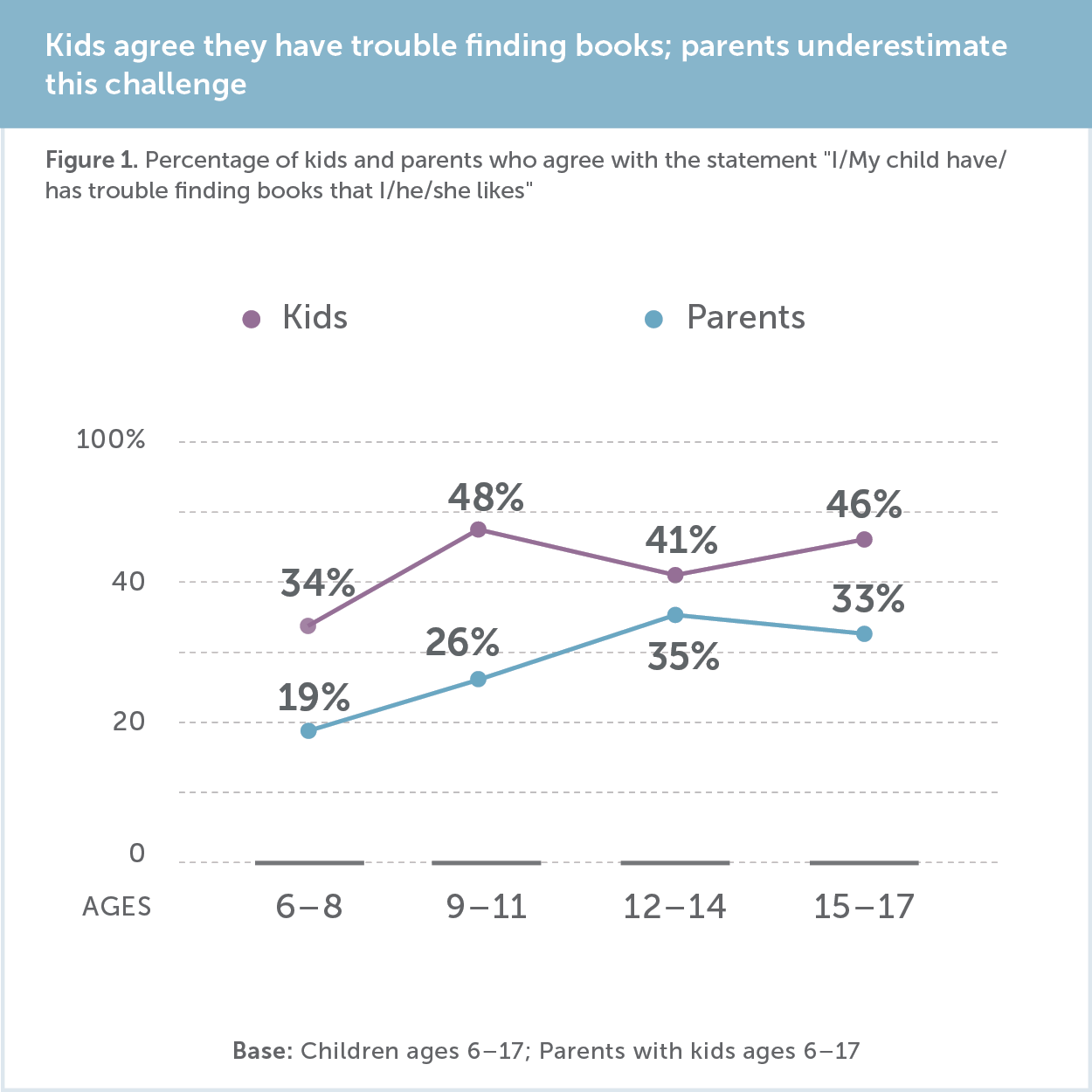
KIDS NEED HELP FINDING BOOKS
Four in 10 kids agree (42%) that they have trouble finding books that they like. This is far higher at 59% among infrequent readers and is true of roughly half of kids by age nine. Similarly, nearly one in three parents (28%) agree that their child has trouble finding books. This percentage increases among parents of infrequent readers and among parents of children older than age eight. Despite a similarity in trend lines, there is a disconnect between parents and kids on this challenge: one-third fewer parents than children think their child has trouble finding books (see Figure 1).
"I was always an avid reader and I read a lot of chapter books to my son when he was younger. I still hope that he will gain more interest in reading for fun. My younger girls are read to often and my seven-year-old is beginning to read on her own now. It's very exciting to watch them all grow and have different levels of fun with books."
—Mother of a 17-year-old boy
Click Here For High-Resolution Image
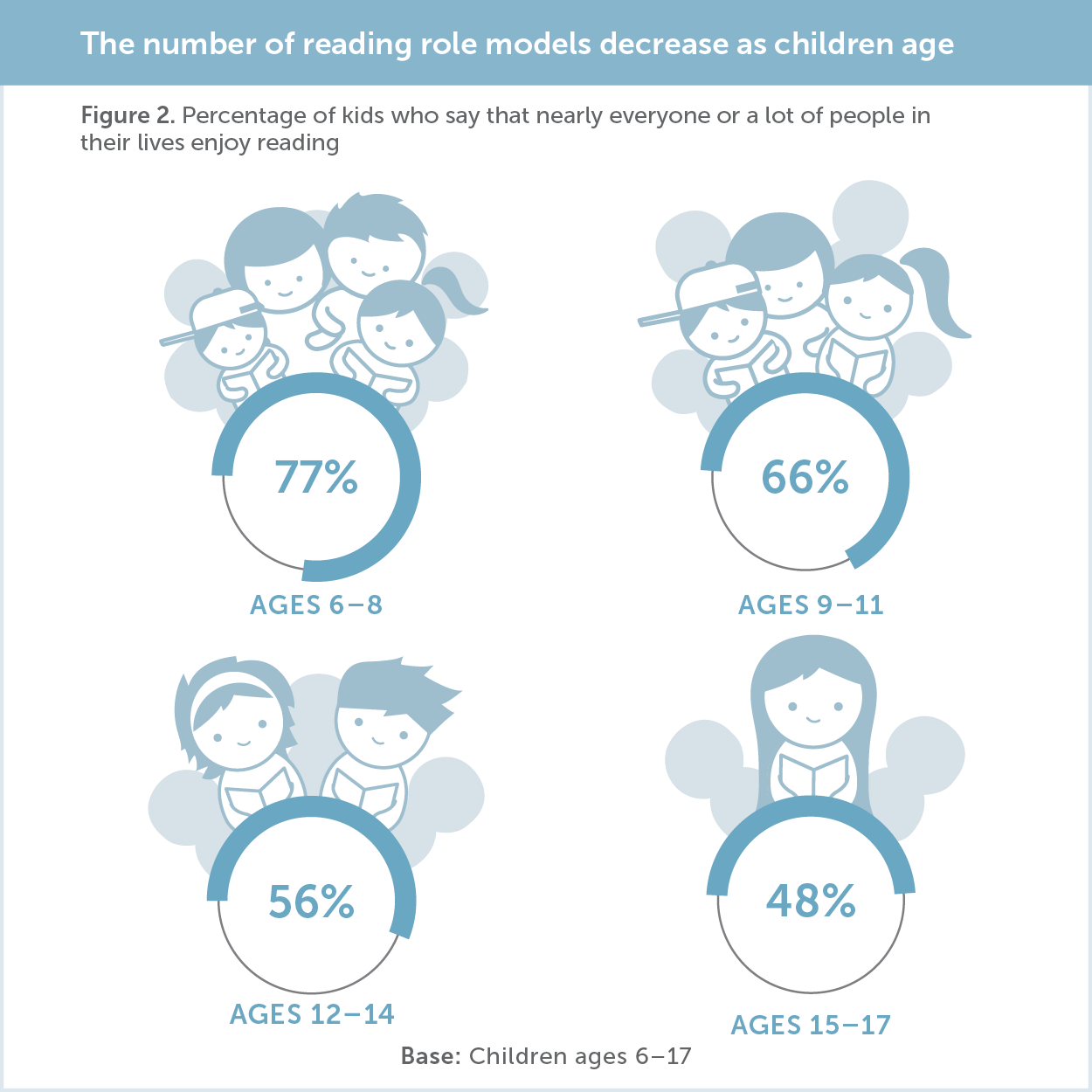
FREQUENT READERS HAVE MORE READING ROLE MODELS
Parents of frequent readers are far more likely to consider reading books for fun important compared to parents of infrequent readers (95% vs. 70%). The difference is most notable when comparing parents who agree reading books for fun is extremely important (70% vs. 27%). Parents of frequent readers are also more likely to be frequent readers themselves (39% vs. 16%).
Frequent readers are also more likely to be surrounded by people who they perceive to enjoy reading: 82% say a lot or nearly everyone they know enjoys reading, versus infrequent readers at 34%. And much like reading frequency decreases as children age, there’s a clear decline in the number of kids who say this: 77% of kids ages 6–8 say a lot or nearly everyone they know enjoys reading, and this drops to 66% among 9–11 year-olds, 56% among 12–14 year-olds, and 48% among 15–17 year-olds (see Figure 2).
Reading role models are critical to instilling reading as an integral part of a child’s life, and do not need to be limited to parents: frequent readers have more encouragement to read from family members, friends, principals, teachers and school librarians than infrequent readers.
As one mother to an 11-year-old boy told us: “We're a family of readers, who enjoy a good story. It's important for mental health, intelligence and personal entertainment."
Click Here For High-Resolution Image
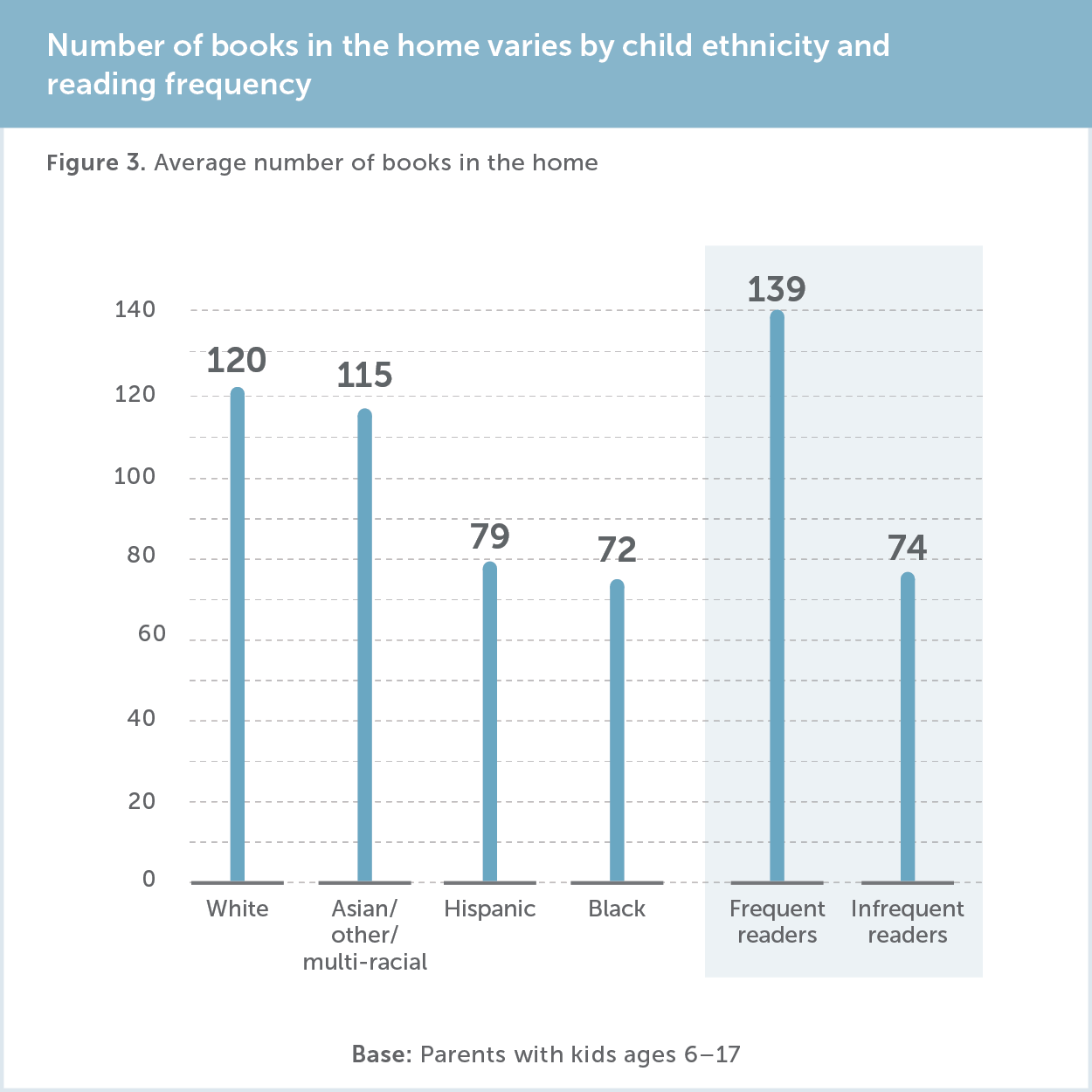
FREQUENT READERS HAVE GREATER ACCESS TO BOOKS AT HOME
Having access to books—whether in or outside the home—is not a reality for all kids. On average, there are 103 books in the home libraries of children ages 6–17, yet this varies widely. Most strikingly, frequent readers have an average of 139 books in their homes vs. 74 in infrequent readers’ homes. Similar trends are seen by income as well as race and ethnicity. Families with incomes of $100,000 or more have nearly twice the amount of books than families with less than $35,000 in annual income (125 vs. 73), and Hispanic and Black children have fewer books in their homes than white, multi-racial, Asian or children of other racial backgrounds (see Figure 3).
"I always had books in my house growing up and I love reading. I make sure my child always has access to books, ebooks, and other different formats of reading."
—Mother of an 11-year-old boy
Click Here For High-Resolution Image
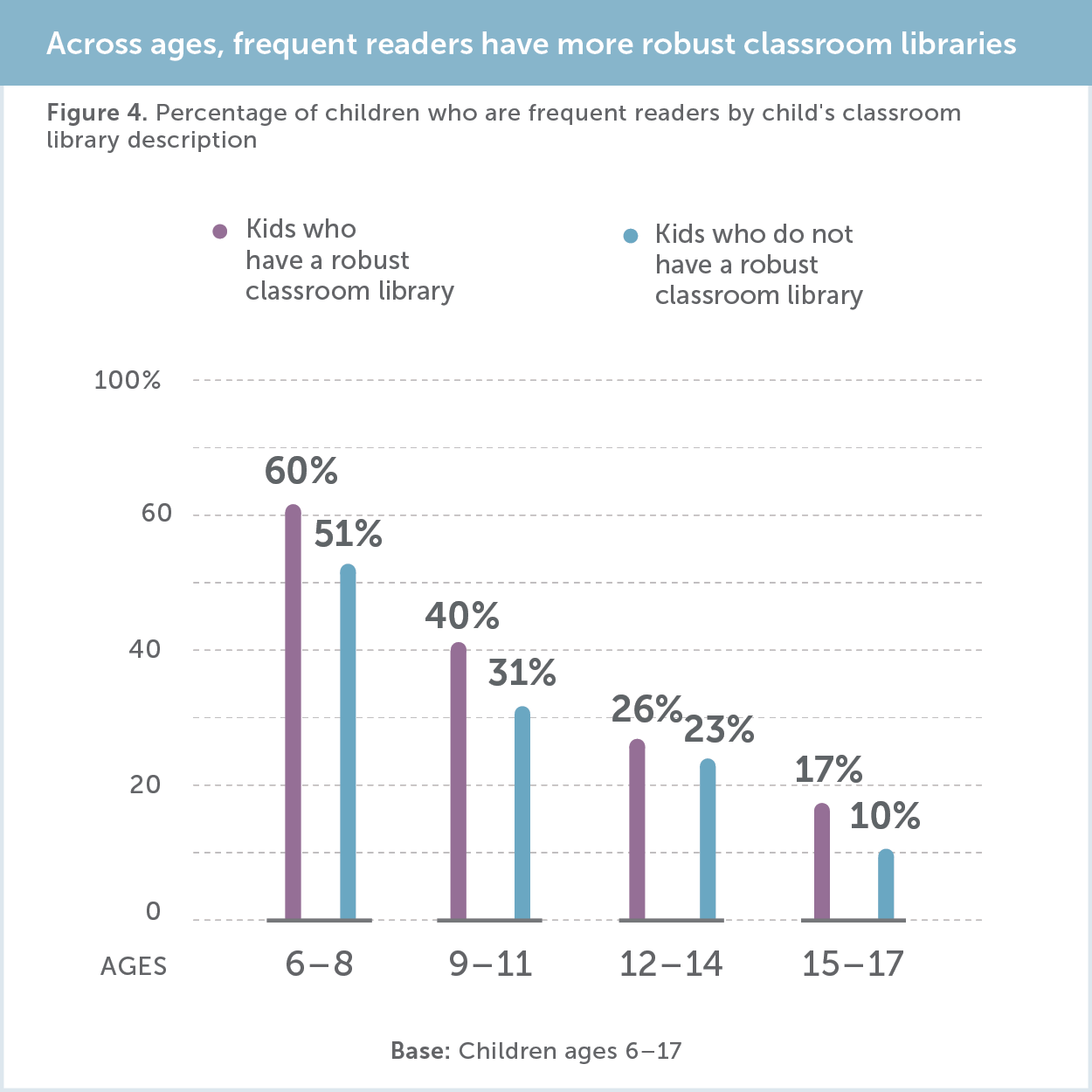
CLASSROOM & SCHOOL LIBRARIES NEED MORE BOOKS KIDS WANT
Adding to the challenges some kids face accessing books at home is the reality of book access at school: classroom libraries—the collection of books teachers have inside the classroom, easily accessible by students—are only available for 43% of school-aged children and only onethird say they have a classroom library that has enough of the types of books they'd like to read. A robust classroom library means the inclusion of books that make kids laugh, books with diverse characters and storylines, and books that provide opportunities to explore the world and allow kids to see themselves in the books.
Classroom libraries are critically important, as across ages of children, kids who have robust classroom libraries are more likely to be frequent readers:
- Among 6–8 year-olds, 60% of kids with a robust classroom library are frequent readers, compared to 51% of kids without a robust classroom library.
- Among 9–11 year-olds, this split is 40% vs. 31% and among 12–14 year-olds, the gap narrows to 26% vs. 23%.
- Among 15–17 year-olds, the gap widens once again with 17% of kids with a robust classroom library being frequent readers, compared to only 10% of kids without a robust classroom library (see Figure 4).
Additionally, while 70% of school-aged children say they have a school library, only 56% say the school library has enough of the books they want to read. Furthermore, it has been well-documented that the number of certified school librarians or library-media specialists per student has been in decline. According to a 2016 analysis of the National Center for Education Statistics (NCES) data conducted by the National Education Association, only 62% of library-media centers in elementary schools are staffed by at least one full-time state-certified librarian/media center specialist. A 2011 study in School Library Journal adds that having library and media specialists leads to higher reading scores among students; meanwhile from the Kids & Family Reading Report, we know that frequent readers are twice as likely to receive encouragement to read books for fun from their school librarian (37% vs. 18%).
Overall, frequent readers are more likely to cite more sources of books including public libraries as well as school book fairs or clubs.
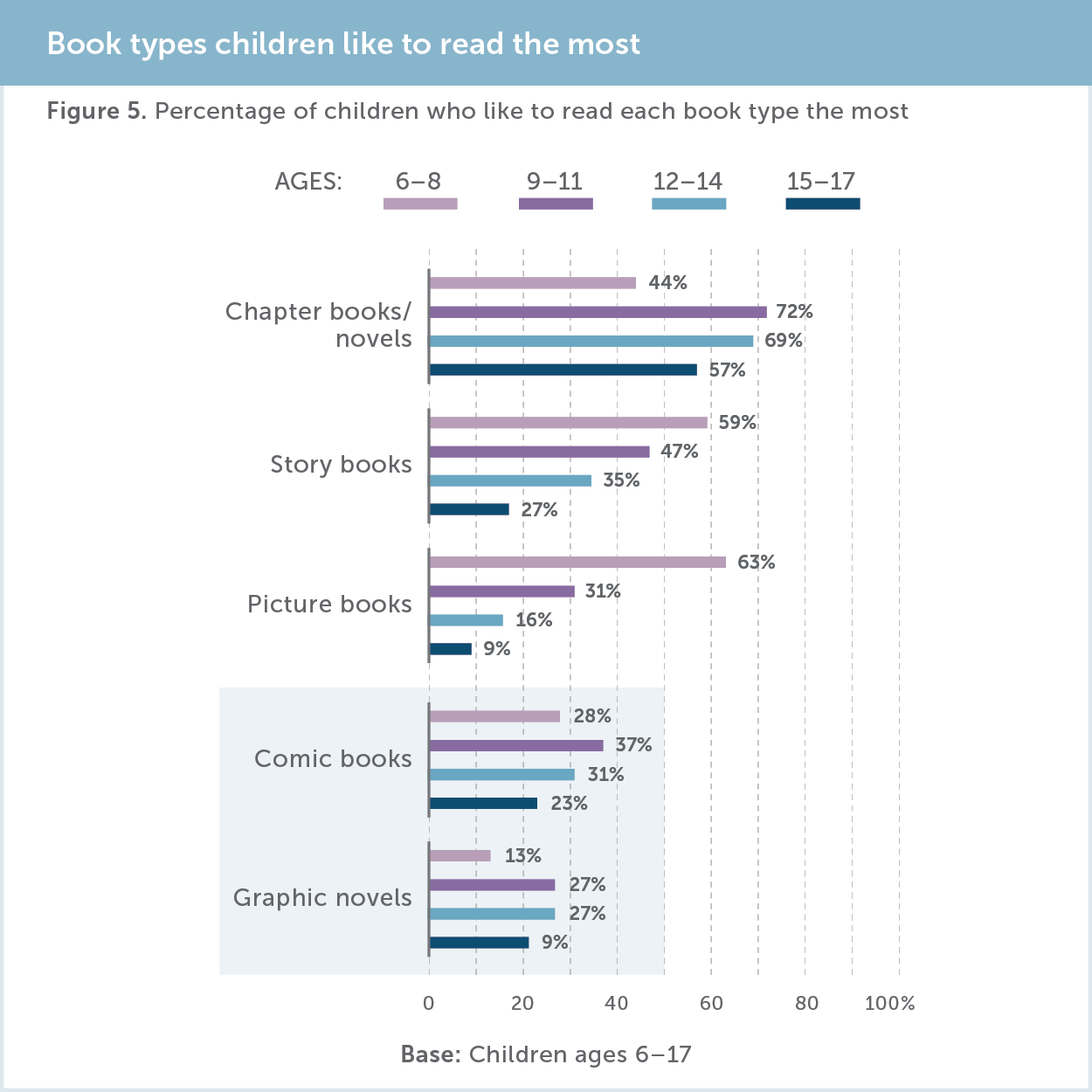
ACCESS INCLUDES A VARIETY OF GENRES AND FORMATS IN BOOK SELECTION
As kids grow older, their list of interests grows with them, and so when providing children access to books, including a variety of genres and formats is helpful. Overall, chapter books and story books are the most popular formats among kids. Chapter books jump in popularity as children become independent readers whereas the popularity of story books begins to decrease—even as about one in three 12–17 year-olds say they like reading story books.
Comic books and graphic novels also begin to capture the attention of kids beginning at age eight, and have a unique appeal as they are nearly equally as popular among frequent, moderate and infrequent readers (see Figure 5).
Additionally, considering magazines can be a motivating approach to building a library. Magazines grow in appeal as children age (rising from 9% of 6–8 year-olds to 19% of 12–17 year-olds), are more popular among Black children (22% vs. 14%), and are the only format preferred among a greater percentage of infrequent readers than frequent readers (21% vs. 13%).
Even though kids continue to agree they will always want books printed on paper (69%), there is value in using technology to support a child’s growth as a reader. Seventy-one percent agree that technology has made it easier for them to find books they would like to read, and 70% of kids who have listened to an audiobook agree that it has encouraged them to read more.
Click Here For High-Resolution Image
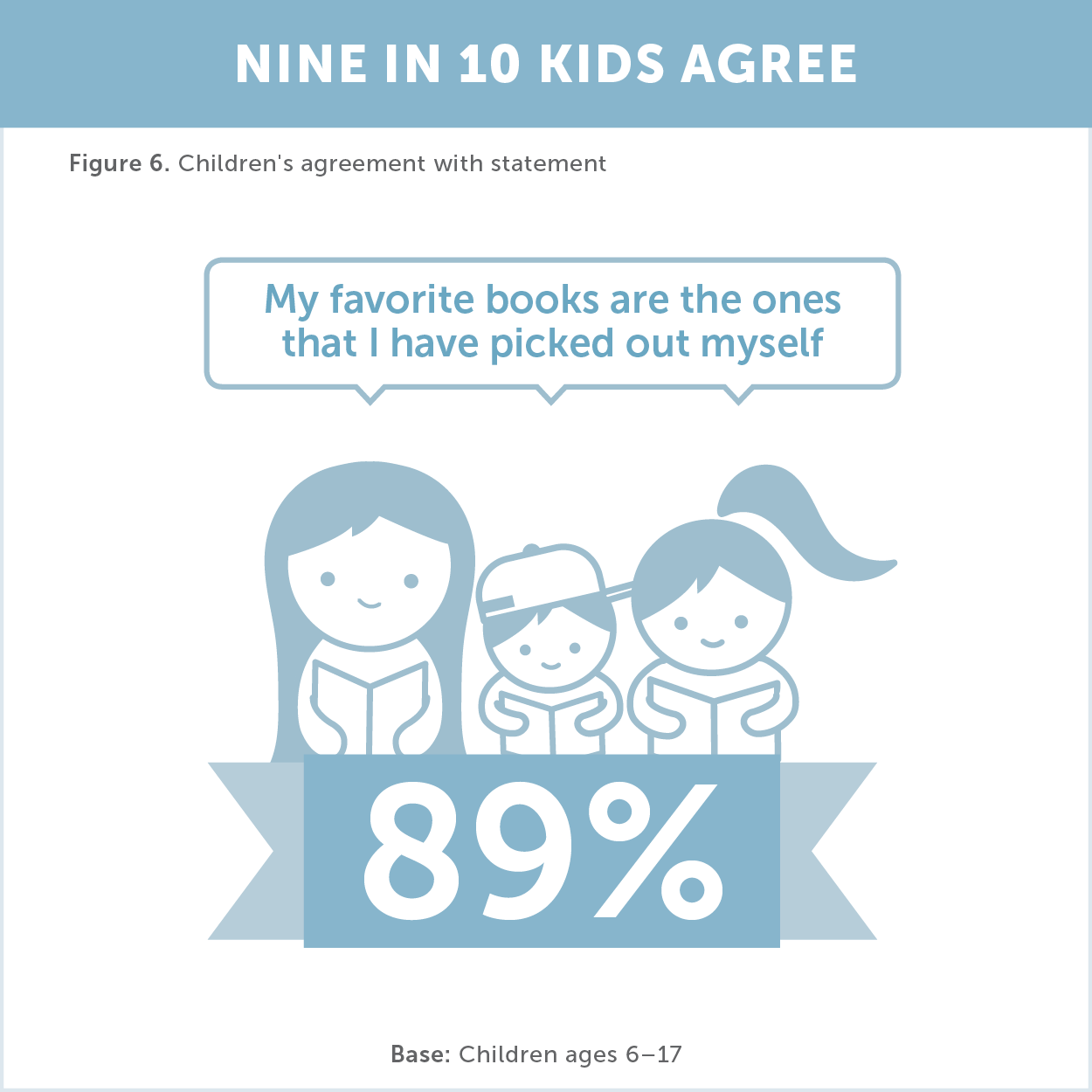
WHEN KIDS CHOOSE, KIDS READ
In the 13 years of the Kids & Family Reading Report, one thing remains constant no matter what: when kids choose, they read. Across demographics, the majority of kids (89%) agree their favorite books are the ones that they have picked out themselves (see Figure 6).
Further, nearly nine in 10 (88%) say they are more likely to finish a book they have picked out themselves and eight in 10 (82%) say they feel a sense of accomplishment when they finish reading a book. Each time these statements have been asked in a Kids & Family Reading Report, even among the most infrequent readers, the data punctuate the opportunity that choice can provide for all children.
"If children get to pick the books and are interested in them, they are more likely to read them, want to read and find more books they enjoy."
—Mother of a 7-year-old boy
Click Here For High-Resolution Image



